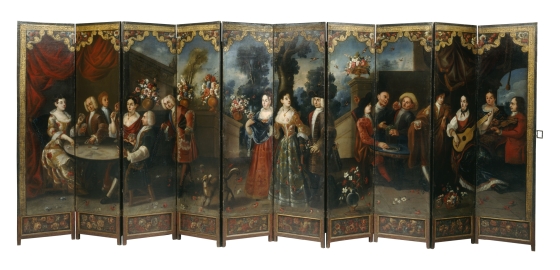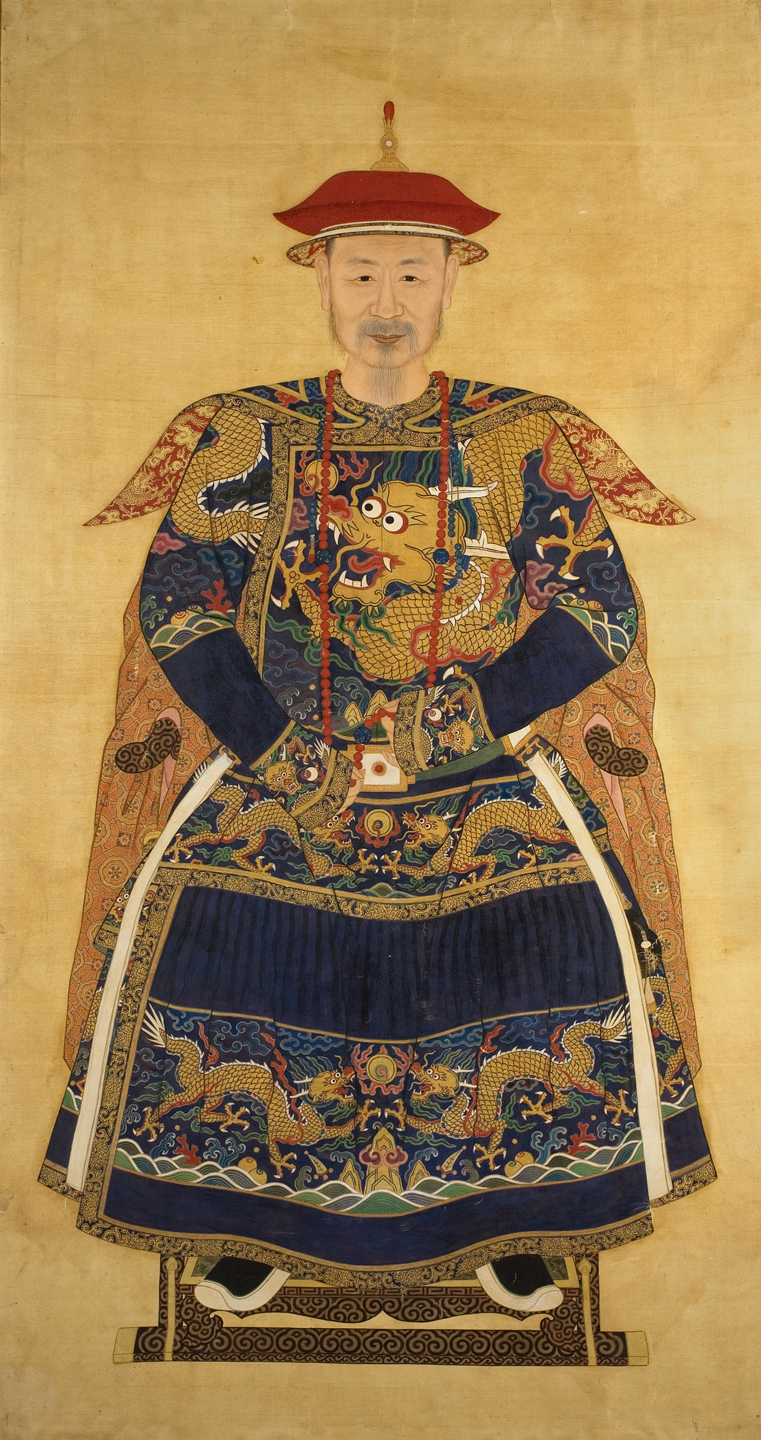Students will observe and visually critique the image of the Garden Party on the Terrace of a Country Home. Students will create a group tableau of a modern version of the painting and photographically record the results for possible later use as a mural or screen.
Students will be able to:
- describe and analyze what they see in the image of Garden Party on the Terrace of a County Home;
- discuss and debate the historical accuracy of representation from various points of view; and
- identify and compare a modern response to the historical work of art.
Lesson
- Show students the image of the Garden Party on the Terrace of a Country Home. Have student describe what they see. Relate what they see to any other styles of art they have seen before. Ask them if they are able to identify any clues as to the culture or age of the object. Have the students guess the country from where this painting came. It might surprise them to know it is from Mexico City during the 1720s-1730s.
- Ask students if they are surprised by this information and if they are why. Share the information from About the Art with the students and discuss the Spanish Colonial period of Latin America that took place from 1521-1821. At this time Spain was a dominant influence on the culture of Mexico, in particular Mexico City.
- Ask students if they can see a European influence on the garden screen and have them point out where. Tell students that art styles from Japan and China also had an influence on Spanish Colonial painting and ask students if they can find examples of that influence, either in style or form.
- Show students the “Details” information and locate those things in the screen.
- Ask students if this scene looks like any party they have been to lately. How? More likely it isn’t. What is different from a party they would attend today? Have students discuss and take notes as they might want to refer to this information later.
- Divide a color copy of the image into four sections. Divide the class into four groups. Give each group a partial image of the screen. Have each group brainstorm how their section of the image would look at a modern party. Gather as many props as possible and have the students act out a tableau of that scene.
- Have the teacher or someone else not involved take a photo of each group in their tableau. Display these photos together below an image of the Garden Party onto the Terrace of a Country Home in the classroom. Discuss the similarities and differences between the original screen and the modern photographs. If time allows or perhaps as a “free-time” project that lasts all class session you could project these photos onto a large screen-sized piece of cardboard, trace and paint the scene into a mural, or divide it up into separate sections and attach them like a screen.
Materials
- Sketch paper for each student
- Pencils with erasers for each student
- Variety of colored pencils, markers, or other media
- One color copy of the image, divided into four sections
- The ability to project the image onto a wall or screen
- Modern versions of various items found in the image of the Garden Party on the Terrace of a Country Home such as a guitar or other musical instruments, games, party attire, food and drink, decorations, etc.
- Digital cameras—could be school owned, personal cameras of students, or cell phone cameras
- Ability to e-mail the photographs to the teacher or download to a school computer
- Ability to project or print the photos taken and display them beside each other
- About the Art section on the Garden Party on the Terrace of a Country Home
- Color copies of the painting for students to share, or the ability to project the image onto a wall or screen
Standards
- Visual Arts
- Invent and Discover to Create
- Observe and Learn to Comprehend
- Relate and Connect to Transfer
- Envision and Critique to Reflect
- Collaboration
- Critical Thinking & Reasoning
- Information Literacy
- Invention
- Self-Direction
Garden Party on the Terrace of a Country Home
- unknown artist
Although we do not know the name of the artist(s) who created this screen, we do know that it was made in Mexico City sometime between 1720 and 1730. During this time, Mexico was part of the area governed by Spain in the New World. The Spanish Colonial period in Latin America lasted for 300 years, from 1521 to 1821. By 1598, the Spanish empire in the Americas spread from present-day southern Colorado to the tip of South America (excluding Brazil). The resulting culture and art is a combination of the European and indigenous cultures. Spanish Colonial artists were also greatly influenced by Asian art, which they encountered through trade.
Folding screens or “Biombos” (bee-ohm-bows) were used in homes to divide spaces, block drafts, and provide privacy. The folding screen form was invented in China, perfected in Japan, and introduced to the Western world through trade in the late 1500s. By the early 1700s, a new genre of screen was invented in Mexico City. Partially derived from a fashion for pastoral paintings in Europe, screen painters began to depict scenes of upper and middle class people enjoying a leisurely afternoon on the garden terrace of a country home. There are only about a dozen screens like this known today, and all were made in Mexico City in the 1700s. These screens provide a glimpse into upper-class life and recreation in Mexico in the 1700s, during the season of summer parties. As is the case with most garden party screens, the people on the left appear more richly or more formally dressed than those on the right. The precise social reason for this is still unknown. It may indicate that both upper and middle class people participated in these festivities. Or it may represent the upper class owners of the summer home and their guests on the left, and the servants or employees, also participating in the festivities, on the right.
Details

Card Players
On the far left, men and women dressed in party clothes sit around a table playing cards. The coins and small beans on the table indicate that they are gambling. The cards they use are an older design—the clubs are actual wooden clubs, the spades are daggers, the hearts are a cup or chalice, and the diamonds are gold coins.
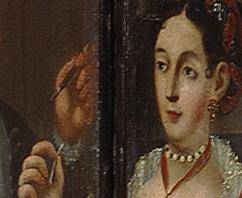
Smoking
The woman on the right side of the table holds a cigarette in her right hand, and the man behind her holds what appears to be a cigar. Tobacco was a New World product and was unknown in Europe before contact with the Americas. In Europe, usually only men smoked tobacco, but in the Americas it was completely acceptable for women of all classes to smoke.

Music
On the right side of the screen a woman sings and plays a distinctive Mexican guitar. The man next to her is playing a violin or fiddle while another woman appears to sing.

Scarves
Both women in the band wear the distinctive Mexican striped rebozo, or rectangular shawl, which is still made in Mexico today. The woman with the guitar also wears a paňuelo, a triangular scarf tied around her neck. This type of scarf was worn by both men and women in Mexico and eventually evolved into the cotton bandanna worn by cowboys.
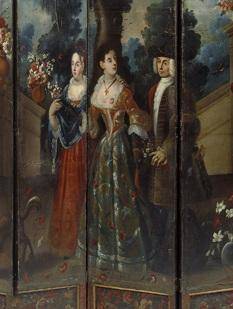
Clothing
The clothing is faithful to the era. All of the women wear full skirts, fitted bodices, elbow-length sleeves, and lace ruffles at the cuffs and necklines. The also wear elaborate jewelry made from gold, pearls, and other stones. The men on the screen all wear knee breeches, stockings, white shirts, and coats of the period. The men also wear powdered white wigs.
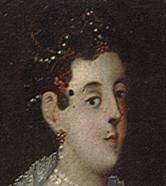
Beauty Marks
Many of the women wear fake beauty marks called chiqueadores. The marks are made from black velvet or tortoiseshell and placed on the women’s temples. Fake beauty marks were very fashionable among women in Europe and the Americas at this time.
Funding for object education resources provided by a grant from the Morgridge Family Foundation. Additional funding provided by the William Randolph Hearst Endowment for Education Programs, and Xcel Energy Foundation. We thank our colleagues at the University of Denver Morgridge College of Education.
The images on this page are intended for classroom use only and may not be reproduced for other reasons without the permission of the Denver Art Museum. This object may not currently be on display at the museum.
